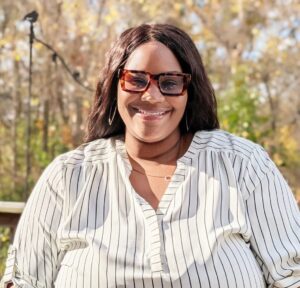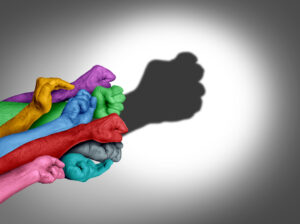The future of DEI: Communicating with intersectional inclusivity during a second Trump term
Omnicom’s Emily Graham on overcoming AI bias, embedding DEI across teams and more.

While Diversity, Equity and Inclusion (DEI) became a weaponized phrase during the Presidential campaign, communicators went above and beyond to strategically advance this work for both internal and external audiences.
With a second Trump presidency on the horizon, it’s worth exploring how communicators plan to address social impact and equity work, at a time when the topic is and will likely continue to be polarized.
Omnicom Global Chief Equity & Impact Officer Emily Graham understands this mission well. The holding company’s global network spans more than 70,000 employees, hundreds of agencies and 5,000 clients. As the head of Omnicom’s Diversity & Inclusion Communications, Graham also understands how to tell the story of this work.
In this moment, Graham believes that communicators are at an inflection point.
“Communicators are having an identity crisis in business for sure, but I think there is about to be an identity crisis among people’s personal identities,” she said. “This is one of the first times I’ve seen it so punctuated.”
Graham recalled Omnicom CEO John Wren’s answers to some questions from the DEI team at a leadership summit a few weeks prior to the election.
Asked by the team what Wren tells other CEOs who are nervous about taking a step back on DEI or clients who wonder whether DEI work is still valuable, he discussed the importance of playing the long game.
“DEI is evolving, but we are not pulling back,” he encouraged the team, “DEI is a key component that helps us win; it fuels our business.”
Graham recalls another recent conversation Wren had with an agency CEO: “It doesn’t matter if clients never ask about DEI, because Omnicom and its agencies have the responsibility to insert it. Clients should know they are already getting a DEI perspective when our teams walk into the room.”
Seeking out the value of intersectionality
As more communicators segment their employee populations to create personas and better personalize messages, it’s worth asking whether the process makes room for intersectional identities.
Considering intersectionality from the outset operationalizes the belief that no person is just one thing — we are shaped by the various parts of our individual identities including gender, race, ability, religion, experiences and much more.
Graham believes we must foster spaces that encourage people to share their intersectional identities in the workplace, which can help create even more inclusivity.
“One of the many reasons that I’m able to do the work that I do at Omnicom is because I have gotten to understand the intersectional identities of our leaders,” she said.
“I now understand my colleagues with LGBTQIA+ children, who have children with disabilities and who identify as having a disability of their own. Those are intersectional identities that further define and describe my colleagues – and they were comfortable sharing this about them with me. I created safe spaces for them to share this aspect about themselves and learned that understanding who they were and what they bring to work with them each day are very valuable insights for me and the work I’m doing, to ensure we’re creating strategies that support them, and I let them know that.”
Embedding intersectionality across the organization
The most effective communicators know how to collaborate across functions and get how building those relationships drives strategic influence of the function across the organization.
Graham double tapped this approach, emphasizing how the cross-functional autonomy of her role empowers her to influence the lens through which Legal, IT, Communications and other functions all think about social equity work.
“Operationalizing intersectionality requires a cultural shift at the company,” said Graham.
That shift occurs when communicators prioritize relationship-building across functions, what Graham calls “relationship capital.”
“That is your currency,” she emphasized, “and in building relationship capital, it becomes easier to share dollars, it becomes easier to share strategy, and it becomes easier to go in on something together.”
Graham shared several examples of this, including partnering with Omnicom Public Relations Group CEO Chris Foster on the Blackweek Economic Forum, and partnering with IT on their recruiting needs.
When communicators bring people together across functions, the DE&I work truly becomes an integrated part of the business.
Graham keeps these touchpoints consistent by regularly hosting road shows about her DEI strategy to garner feedback, table talks to get stakeholder input, and other intentional gatherings.
“I went to the influencers I needed, welcomed them in, and now they welcome me in,” she explained. “It’s like media relations, but within your organization.”
This culture of collaboration makes all parties feel more invested and makes room for more seats at the DEI table. “Sometimes people just want a seat at the table, to be brought in and to understand ‘the why’ behind it,” said Graham.
Educating the AI trainers on spotting bias
When comms effectively partners with tech, intersectional inclusivity is woven into product design and future-focused integrations like AI.
“A year ago at CES, I moderated a panel on inclusive AI and people wondered, ‘What did DE&I have to do with artificial intelligence?’ Now they’re more fluent in talking about bias and algorithms,” Graham said.
As AI becomes integral to our comms workflows, Graham stressed that “we have a responsibility to insert inclusiveness into the system and the model.” This requires team members to be able to spot and correct stereotypes or biases when they arise.
Communicators can influence this by educating the trainers of AI systems.
“It’s important that we all – particularly those in demographic majority groups –know enough about common racial stereotypes and tropes to correct the model,” Graham said, emphasizing that the responsibility of spotting bias shouldn’t solely fall on your colleagues from underrepresented communities.
“If I tell ChatGPT to show me a middle-aged man in Detroit, and it spits back an image that could be considered a stereotype — an “urban” guy in a hoodie with gold chains — we must train users to recognize that and correct it,” she added.
“We take all our colleagues working with generative AI through bias and ethics training so that they can start to catch stuff like that, and they become a lot more comfortable in flagging it and training the models.”
Practicing strategic bravery
While the future of this work seems unwritten, Graham said that communicating in uncertain times requires moving forward with resilience.
“I feel really good that we’ve spent the past four years making inroads, and I think that’s going to be very helpful for us in the next four years,” she said.
“As we move forward, let’s be confident in knowing what we’re doing is right and how we’re doing it is right. Let’s be cohesive, let’s be thoughtful, strategic and brave.”
Justin Joffe is the editorial director and editor-in-chief at Ragan Communications. Follow him on LinkedIn.







